FIAT 500L 2017 2.G Workshop Manual
Manufacturer: FIAT, Model Year: 2017, Model line: 500L, Model: FIAT 500L 2017 2.GPages: 370, PDF Size: 3.56 MB
Page 51 of 370
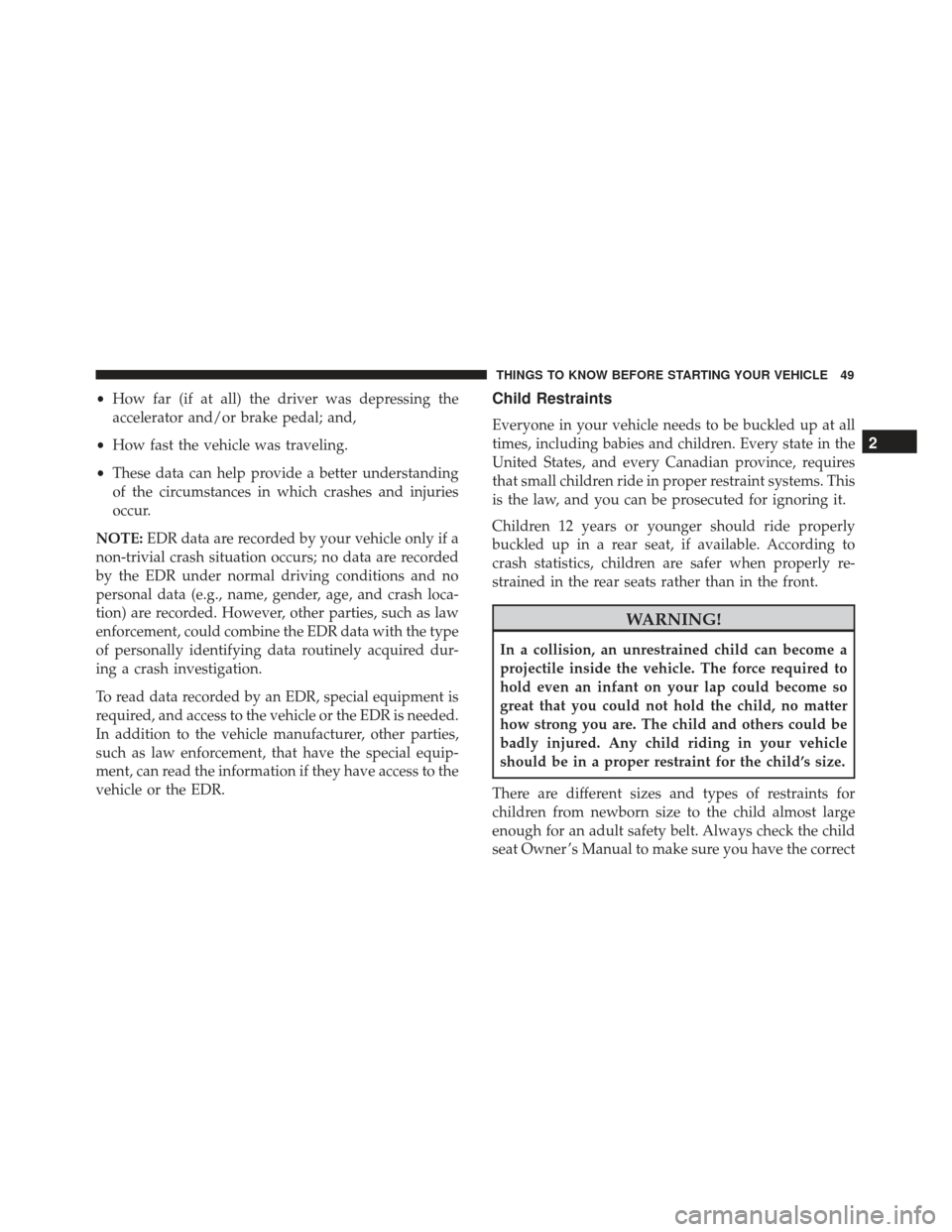
•How far (if at all) the driver was depressing the
accelerator and/or brake pedal; and,
• How fast the vehicle was traveling.
• These data can help provide a better understanding
of the circumstances in which crashes and injuries
occur.
NOTE: EDR data are recorded by your vehicle only if a
non-trivial crash situation occurs; no data are recorded
by the EDR under normal driving conditions and no
personal data (e.g., name, gender, age, and crash loca-
tion) are recorded. However, other parties, such as law
enforcement, could combine the EDR data with the type
of personally identifying data routinely acquired dur-
ing a crash investigation.
To read data recorded by an EDR, special equipment is
required, and access to the vehicle or the EDR is needed.
In addition to the vehicle manufacturer, other parties,
such as law enforcement, that have the special equip-
ment, can read the information if they have access to the
vehicle or the EDR.Child Restraints
Everyone in your vehicle needs to be buckled up at all
times, including babies and children. Every state in the
United States, and every Canadian province, requires
that small children ride in proper restraint systems. This
is the law, and you can be prosecuted for ignoring it.
Children 12 years or younger should ride properly
buckled up in a rear seat, if available. According to
crash statistics, children are safer when properly re-
strained in the rear seats rather than in the front.
WARNING!
In a collision, an unrestrained child can become a
projectile inside the vehicle. The force required to
hold even an infant on your lap could become so
great that you could not hold the child, no matter
how strong you are. The child and others could be
badly injured. Any child riding in your vehicle
should be in a proper restraint for the child’s size.
There are different sizes and types of restraints for
children from newborn size to the child almost large
enough for an adult safety belt. Always check the child
seat Owner ’s Manual to make sure you have the correct
2
THINGS TO KNOW BEFORE STARTING YOUR VEHICLE 49
Page 52 of 370
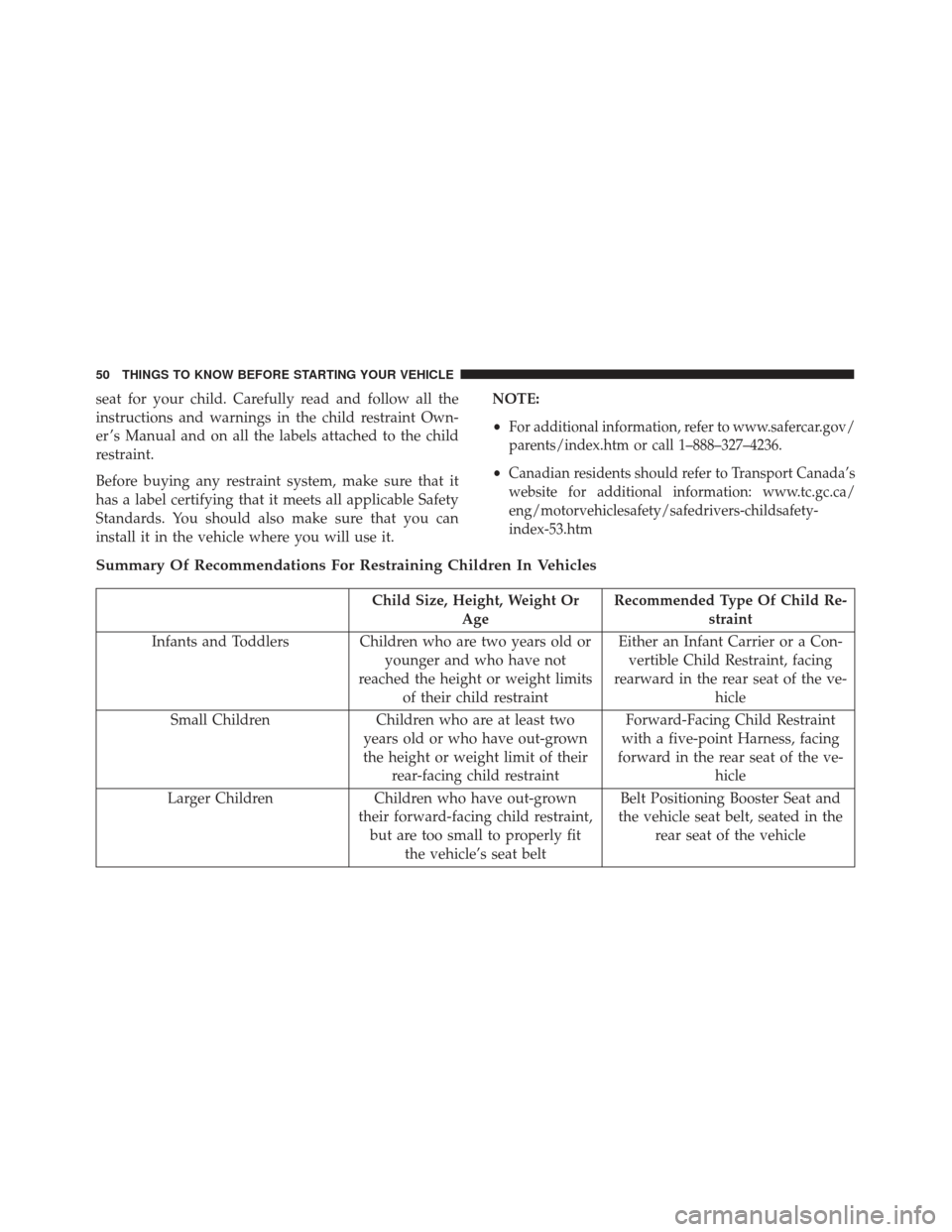
seat for your child. Carefully read and follow all the
instructions and warnings in the child restraint Own-
er ’s Manual and on all the labels attached to the child
restraint.
Before buying any restraint system, make sure that it
has a label certifying that it meets all applicable Safety
Standards. You should also make sure that you can
install it in the vehicle where you will use it.NOTE:
•
For additional information, refer to www.safercar.gov/
parents/index.htm or call 1–888–327–4236.
•Canadian residents should refer to Transport Canada’s
website for additional information: www.tc.gc.ca/
eng/motorvehiclesafety/safedrivers-childsafety-
index-53.htm
Summary Of Recommendations For Restraining Children In Vehicles
Child Size, Height, Weight Or
Age Recommended Type Of Child Re-
straint
Infants and Toddlers Children who are two years old or younger and who have not
reached the height or weight limits of their child restraint Either an Infant Carrier or a Con-
vertible Child Restraint, facing
rearward in the rear seat of the ve- hicle
Small Children Children who are at least two
years old or who have out-grown
the height or weight limit of their rear-facing child restraint Forward-Facing Child Restraint
with a five-point Harness, facing
forward in the rear seat of the ve- hicle
Larger Children Children who have out-grown
their forward-facing child restraint, but are too small to properly fit the vehicle’s seat belt Belt Positioning Booster Seat and
the vehicle seat belt, seated in the rear seat of the vehicle
50 THINGS TO KNOW BEFORE STARTING YOUR VEHICLE
Page 53 of 370
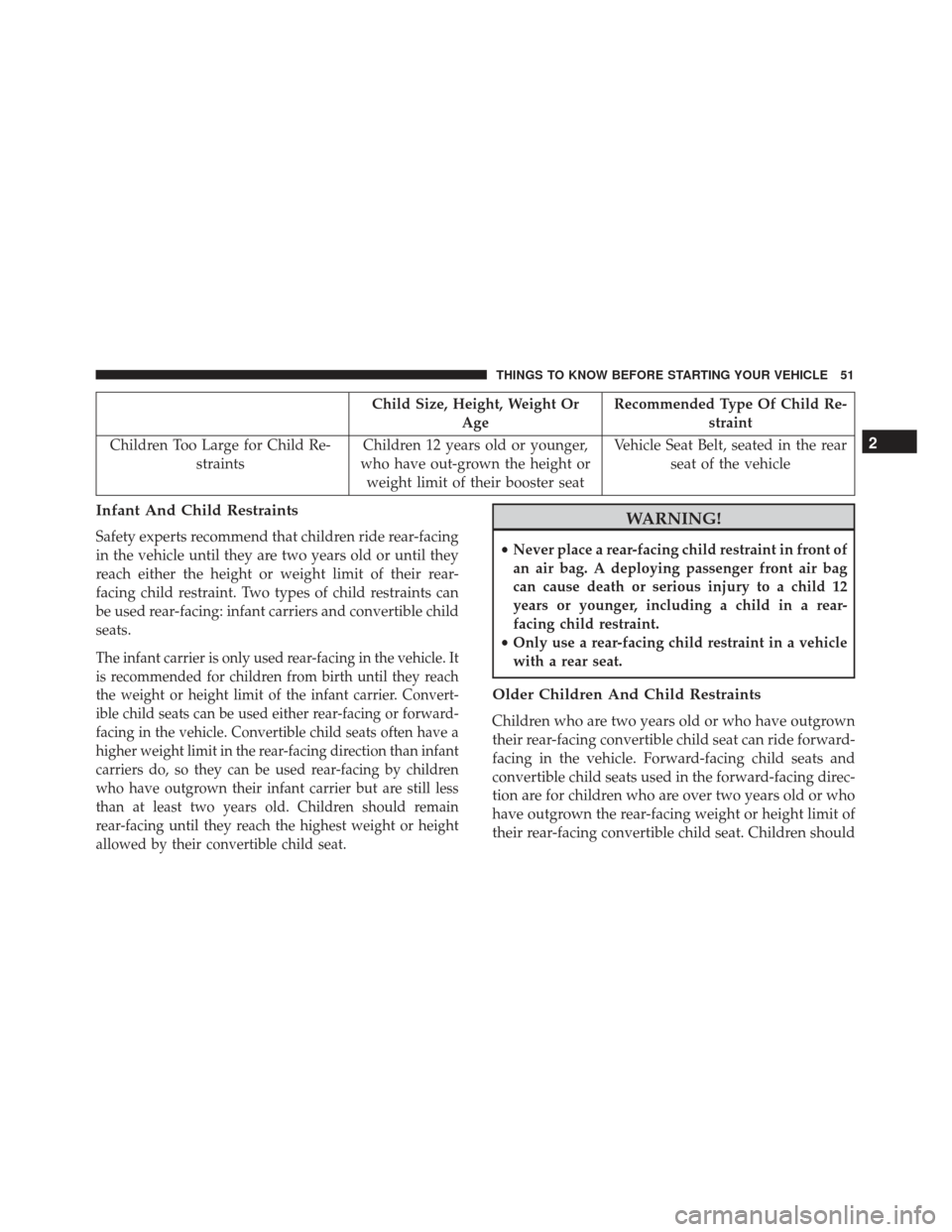
Child Size, Height, Weight OrAge Recommended Type Of Child Re-
straint
Children Too Large for Child Re- straints Children 12 years old or younger,
who have out-grown the height or weight limit of their booster seat Vehicle Seat Belt, seated in the rear
seat of the vehicle
Infant And Child Restraints
Safety experts recommend that children ride rear-facing
in the vehicle until they are two years old or until they
reach either the height or weight limit of their rear-
facing child restraint. Two types of child restraints can
be used rear-facing: infant carriers and convertible child
seats.
The infant carrier is only used rear-facing in the vehicle. It
is recommended for children from birth until they reach
the weight or height limit of the infant carrier. Convert-
ible child seats can be used either rear-facing or forward-
facing in the vehicle. Convertible child seats often have a
higher weight limit in the rear-facing direction than infant
carriers do, so they can be used rear-facing by children
who have outgrown their infant carrier but are still less
than at least two years old. Children should remain
rear-facing until they reach the highest weight or height
allowed by their convertible child seat.
WARNING!
•Never place a rear-facing child restraint in front of
an air bag. A deploying passenger front air bag
can cause death or serious injury to a child 12
years or younger, including a child in a rear-
facing child restraint.
• Only use a rear-facing child restraint in a vehicle
with a rear seat.
Older Children And Child Restraints
Children who are two years old or who have outgrown
their rear-facing convertible child seat can ride forward-
facing in the vehicle. Forward-facing child seats and
convertible child seats used in the forward-facing direc-
tion are for children who are over two years old or who
have outgrown the rear-facing weight or height limit of
their rear-facing convertible child seat. Children should
2
THINGS TO KNOW BEFORE STARTING YOUR VEHICLE 51
Page 54 of 370
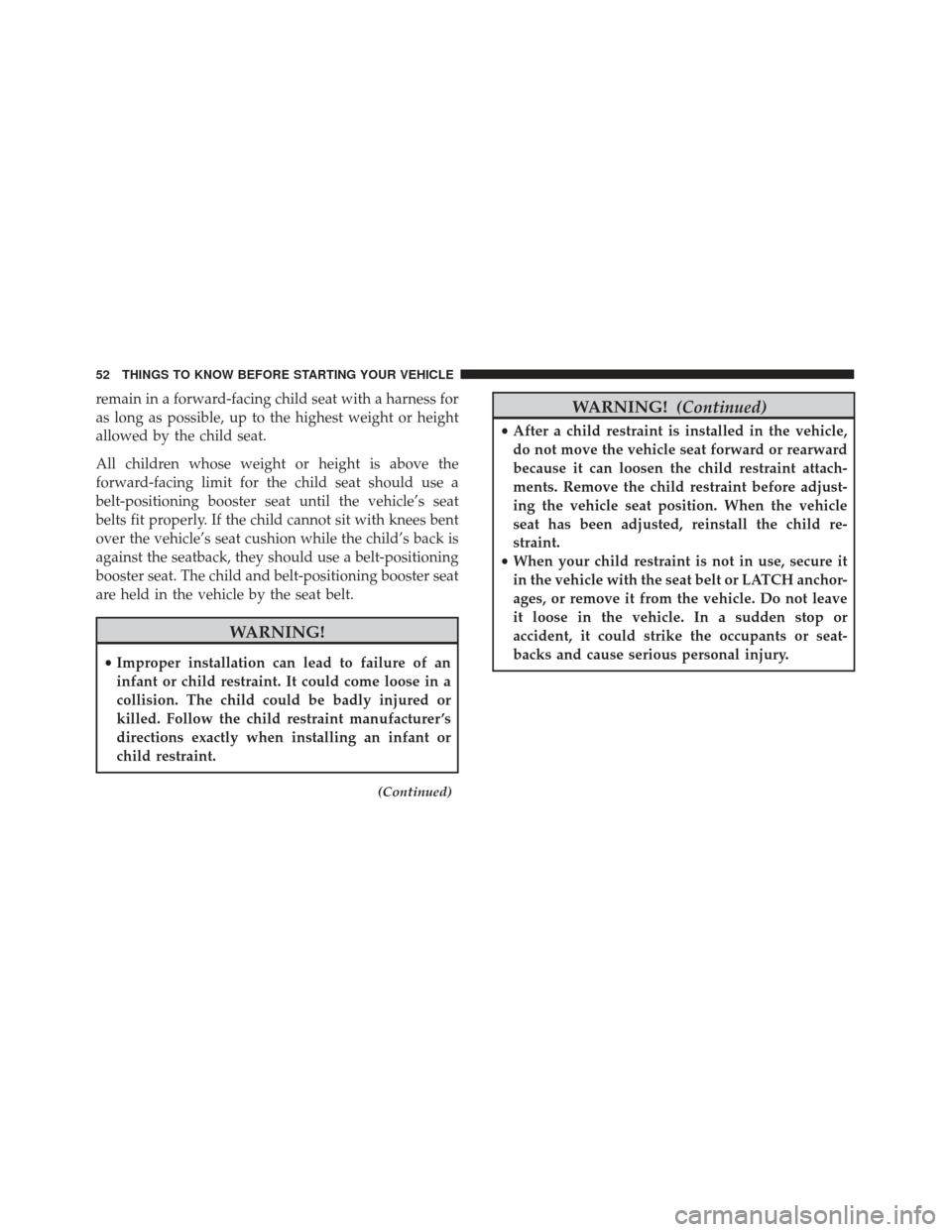
remain in a forward-facing child seat with a harness for
as long as possible, up to the highest weight or height
allowed by the child seat.
All children whose weight or height is above the
forward-facing limit for the child seat should use a
belt-positioning booster seat until the vehicle’s seat
belts fit properly. If the child cannot sit with knees bent
over the vehicle’s seat cushion while the child’s back is
against the seatback, they should use a belt-positioning
booster seat. The child and belt-positioning booster seat
are held in the vehicle by the seat belt.
WARNING!
•Improper installation can lead to failure of an
infant or child restraint. It could come loose in a
collision. The child could be badly injured or
killed. Follow the child restraint manufacturer ’s
directions exactly when installing an infant or
child restraint.
(Continued)
WARNING! (Continued)
•After a child restraint is installed in the vehicle,
do not move the vehicle seat forward or rearward
because it can loosen the child restraint attach-
ments. Remove the child restraint before adjust-
ing the vehicle seat position. When the vehicle
seat has been adjusted, reinstall the child re-
straint.
• When your child restraint is not in use, secure it
in the vehicle with the seat belt or LATCH anchor-
ages, or remove it from the vehicle. Do not leave
it loose in the vehicle. In a sudden stop or
accident, it could strike the occupants or seat-
backs and cause serious personal injury.
52 THINGS TO KNOW BEFORE STARTING YOUR VEHICLE
Page 55 of 370
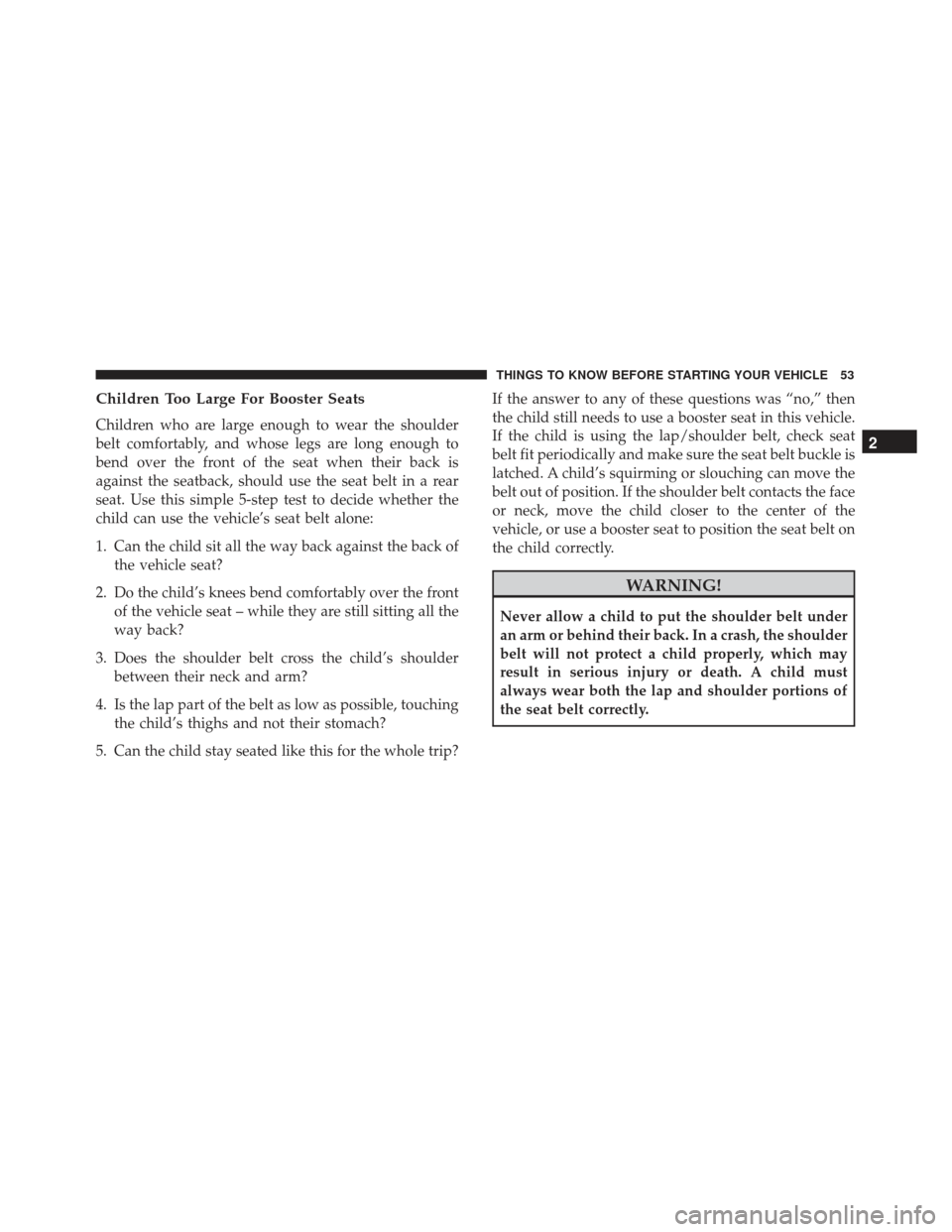
Children Too Large For Booster Seats
Children who are large enough to wear the shoulder
belt comfortably, and whose legs are long enough to
bend over the front of the seat when their back is
against the seatback, should use the seat belt in a rear
seat. Use this simple 5-step test to decide whether the
child can use the vehicle’s seat belt alone:
1. Can the child sit all the way back against the back ofthe vehicle seat?
2. Do the child’s knees bend comfortably over the front of the vehicle seat – while they are still sitting all the
way back?
3. Does the shoulder belt cross the child’s shoulder between their neck and arm?
4. Is the lap part of the belt as low as possible, touching the child’s thighs and not their stomach?
5. Can the child stay seated like this for the whole trip? If the answer to any of these questions was “no,” then
the child still needs to use a booster seat in this vehicle.
If the child is using the lap/shoulder belt, check seat
belt fit periodically and make sure the seat belt buckle is
latched. A child’s squirming or slouching can move the
belt out of position. If the shoulder belt contacts the face
or neck, move the child closer to the center of the
vehicle, or use a booster seat to position the seat belt on
the child correctly.
WARNING!
Never allow a child to put the shoulder belt under
an arm or behind their back. In a crash, the shoulder
belt will not protect a child properly, which may
result in serious injury or death. A child must
always wear both the lap and shoulder portions of
the seat belt correctly.
2
THINGS TO KNOW BEFORE STARTING YOUR VEHICLE 53
Page 56 of 370
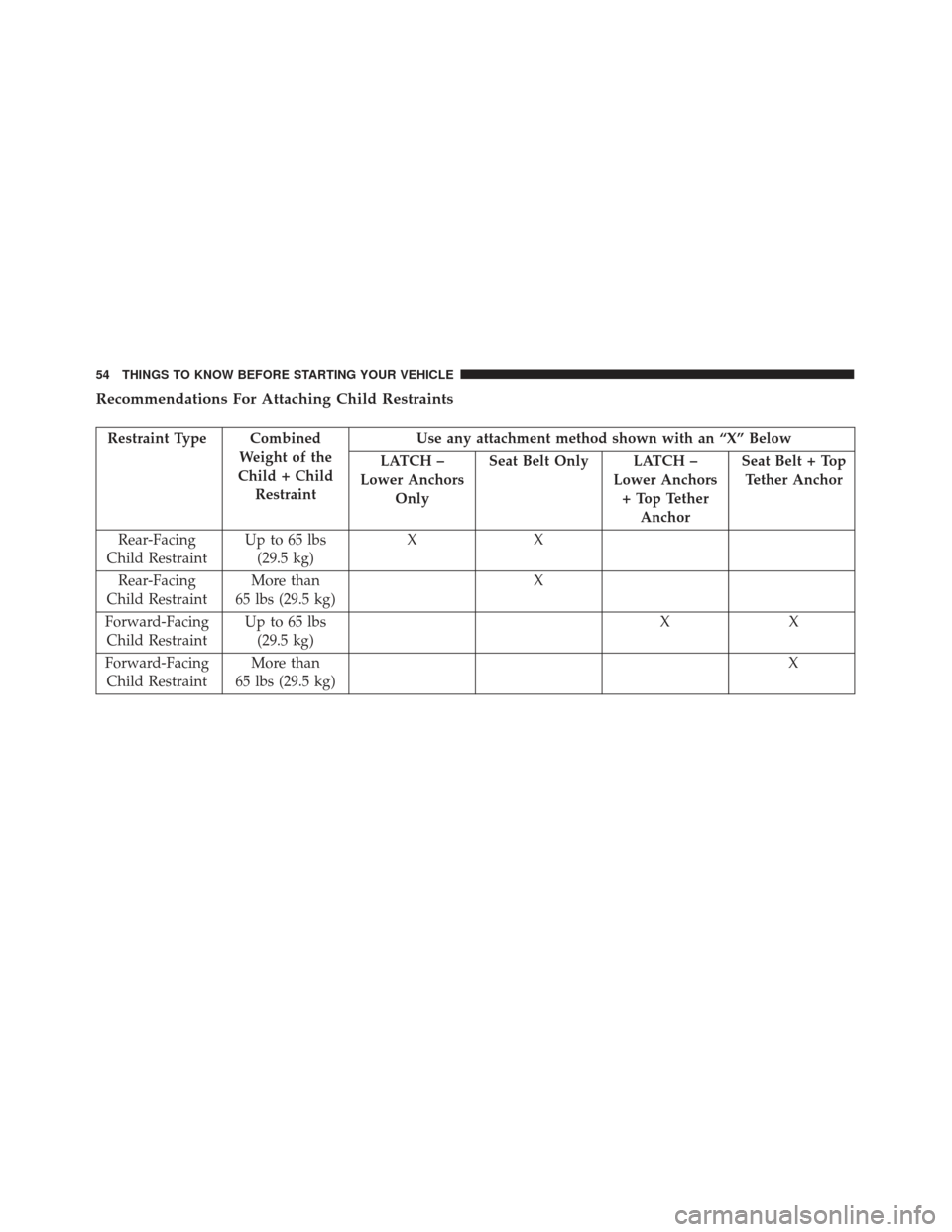
Recommendations For Attaching Child Restraints
Restraint Type CombinedWeight of the
Child + Child Restraint Use any attachment method shown with an “X” Below
LATCH –
Lower Anchors Only Seat Belt Only LATCH –
Lower Anchors+ Top Tether Anchor Seat Belt + Top
Tether Anchor
Rear-Facing
Child Restraint Up to 65 lbs
(29.5 kg) XX
Rear-Facing
Child Restraint More than
65 lbs (29.5 kg) X
Forward-Facing Child Restraint Up to 65 lbs
(29.5 kg) XX
Forward-Facing Child Restraint More than
65 lbs (29.5 kg) X
54 THINGS TO KNOW BEFORE STARTING YOUR VEHICLE
Page 57 of 370
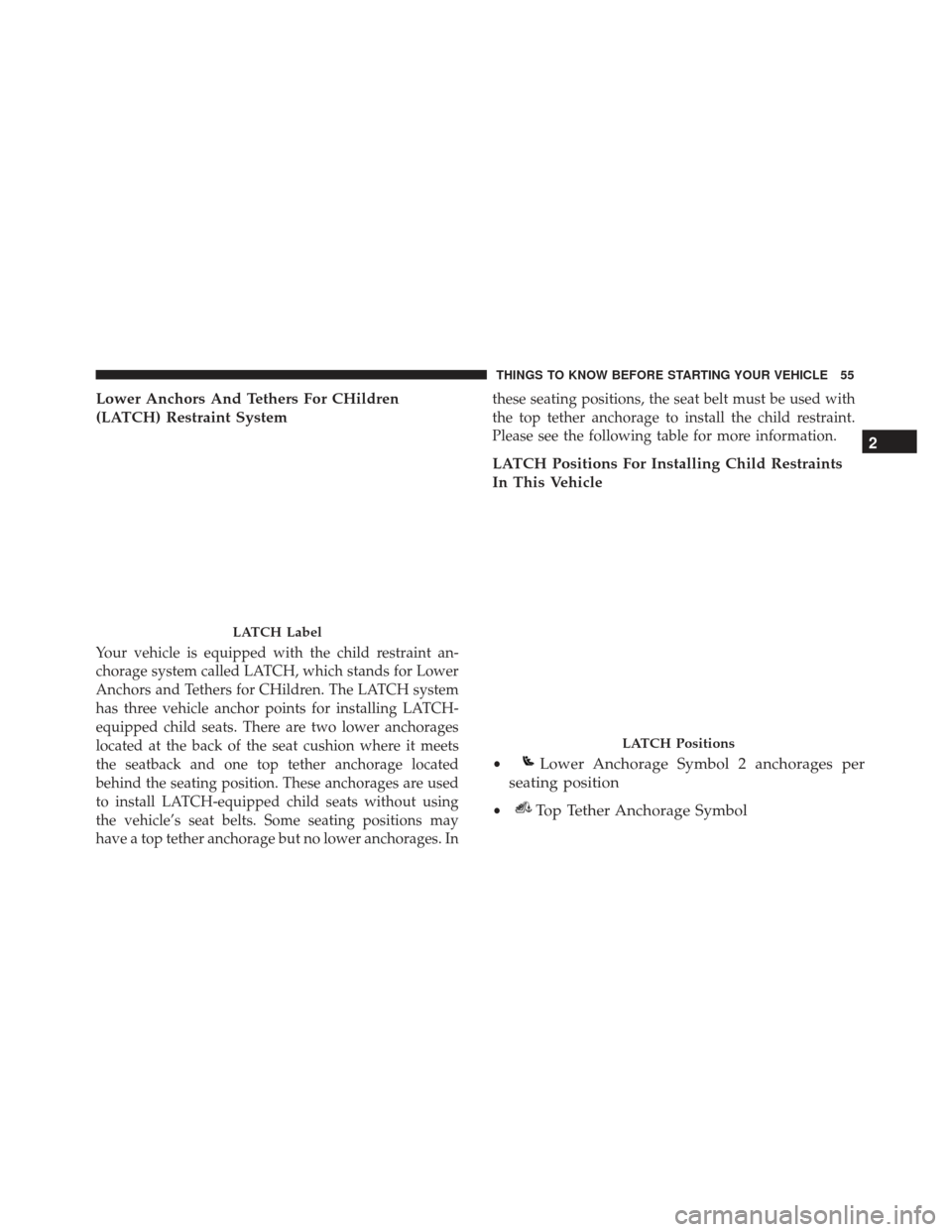
Lower Anchors And Tethers For CHildren
(LATCH) Restraint System
Your vehicle is equipped with the child restraint an-
chorage system called LATCH, which stands for Lower
Anchors and Tethers for CHildren. The LATCH system
has three vehicle anchor points for installing LATCH-
equipped child seats. There are two lower anchorages
located at the back of the seat cushion where it meets
the seatback and one top tether anchorage located
behind the seating position. These anchorages are used
to install LATCH-equipped child seats without using
the vehicle’s seat belts. Some seating positions may
have a top tether anchorage but no lower anchorages. Inthese seating positions, the seat belt must be used with
the top tether anchorage to install the child restraint.
Please see the following table for more information.
LATCH Positions For Installing Child Restraints
In This Vehicle
LATCH Label
LATCH Positions
•Lower Anchorage Symbol 2 anchorages per
seating position
•Top Tether Anchorage Symbol 2
THINGS TO KNOW BEFORE STARTING YOUR VEHICLE 55
Page 58 of 370
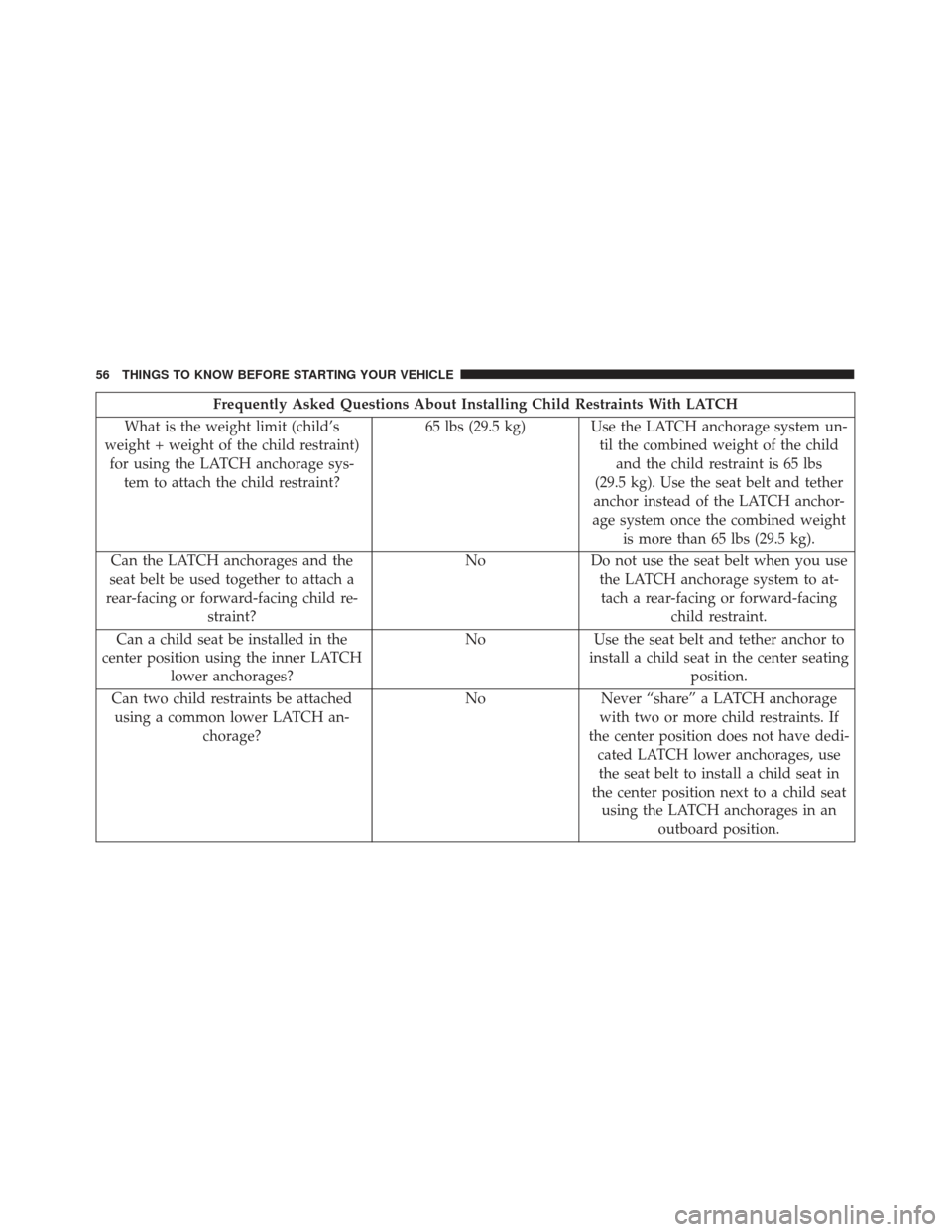
Frequently Asked Questions About Installing Child Restraints With LATCH
What is the weight limit (child’s
weight + weight of the child restraint) for using the LATCH anchorage sys- tem to attach the child restraint? 65 lbs (29.5 kg) Use the LATCH anchorage system un-
til the combined weight of the childand the child restraint is 65 lbs
(29.5 kg). Use the seat belt and tether
anchor instead of the LATCH anchor-
age system once the combined weight is more than 65 lbs (29.5 kg).
Can the LATCH anchorages and the
seat belt be used together to attach a
rear-facing or forward-facing child re- straint? No
Do not use the seat belt when you use
the LATCH anchorage system to at-tach a rear-facing or forward-facing child restraint.
Can a child seat be installed in the
center position using the inner LATCH lower anchorages? No
Use the seat belt and tether anchor to
install a child seat in the center seating position.
Can two child restraints be attached using a common lower LATCH an- chorage? No
Never “share” a LATCH anchorage
with two or more child restraints. If
the center position does not have dedi- cated LATCH lower anchorages, usethe seat belt to install a child seat in
the center position next to a child seat using the LATCH anchorages in an outboard position.
56 THINGS TO KNOW BEFORE STARTING YOUR VEHICLE
Page 59 of 370
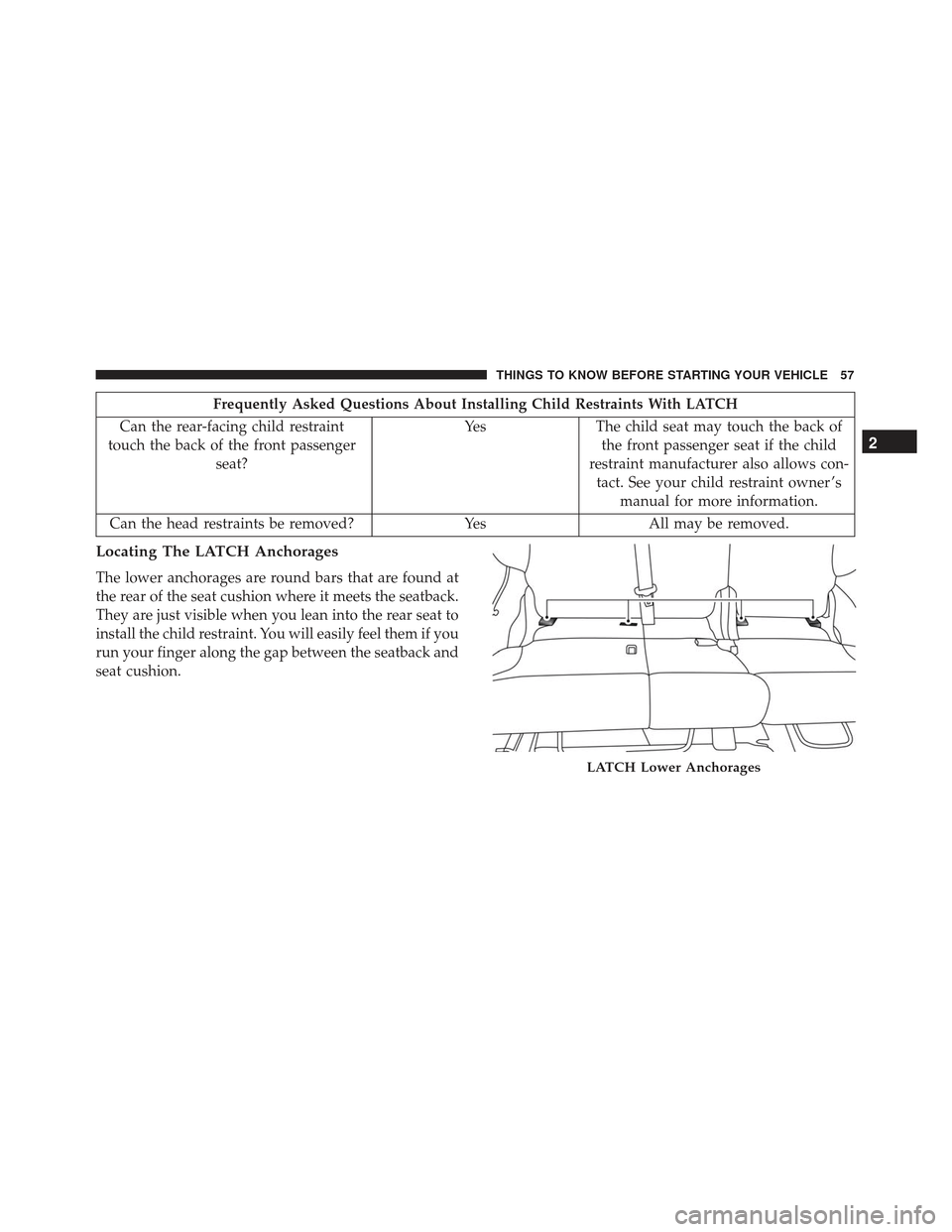
Frequently Asked Questions About Installing Child Restraints With LATCH
Can the rear-facing child restraint
touch the back of the front passenger seat? Yes
The child seat may touch the back of
the front passenger seat if the child
restraint manufacturer also allows con- tact. See your child restraint owner ’s manual for more information.
Can the head restraints be removed? YesAll may be removed.
Locating The LATCH Anchorages
The lower anchorages are round bars that are found at
the rear of the seat cushion where it meets the seatback.
They are just visible when you lean into the rear seat to
install the child restraint. You will easily feel them if you
run your finger along the gap between the seatback and
seat cushion.
LATCH Lower Anchorages
2
THINGS TO KNOW BEFORE STARTING YOUR VEHICLE 57
Page 60 of 370
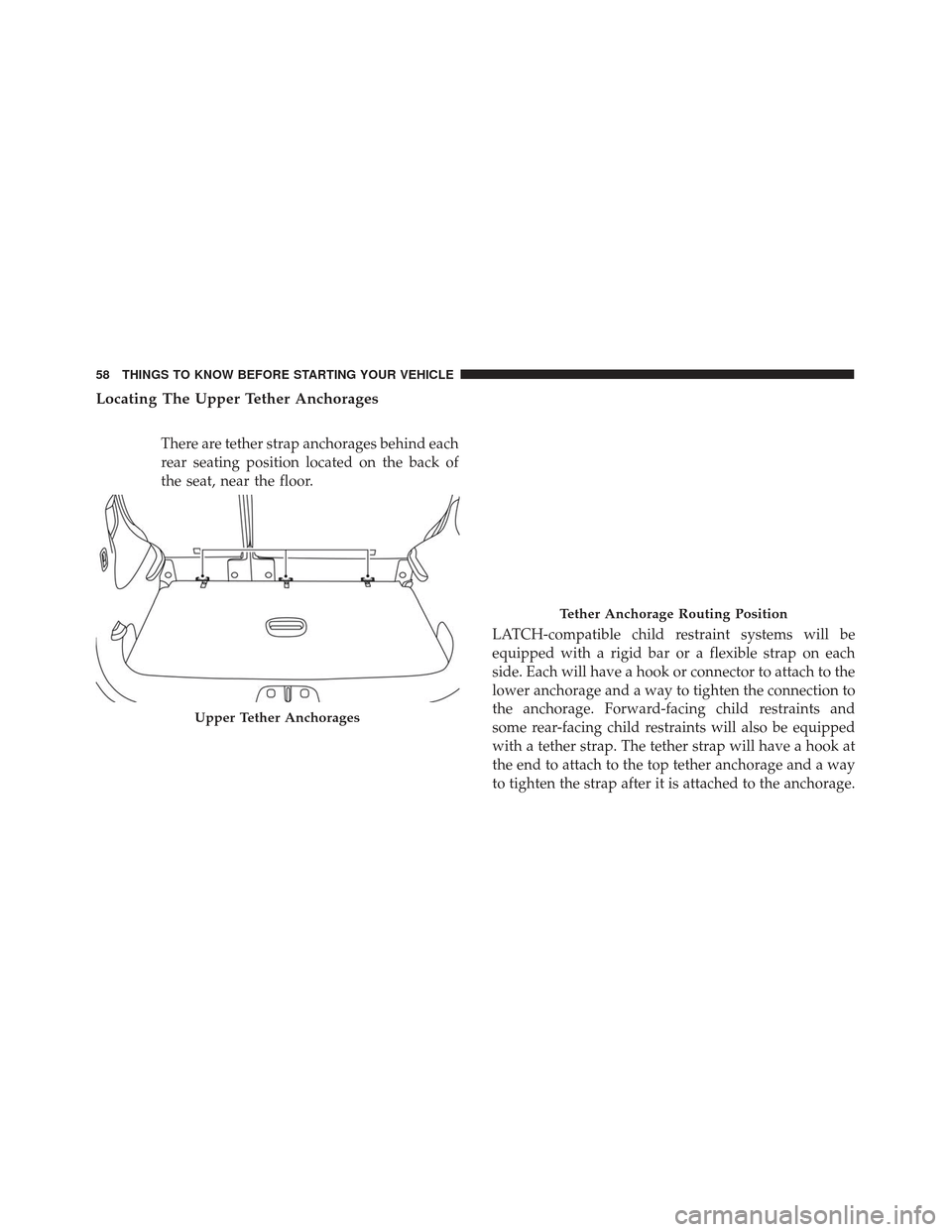
Locating The Upper Tether Anchorages
There are tether strap anchorages behind each
rear seating position located on the back of
the seat, near the floor.LATCH-compatible child restraint systems will be
equipped with a rigid bar or a flexible strap on each
side. Each will have a hook or connector to attach to the
lower anchorage and a way to tighten the connection to
the anchorage. Forward-facing child restraints and
some rear-facing child restraints will also be equipped
with a tether strap. The tether strap will have a hook at
the end to attach to the top tether anchorage and a way
to tighten the strap after it is attached to the anchorage.
Upper Tether Anchorages
Tether Anchorage Routing Position
58 THINGS TO KNOW BEFORE STARTING YOUR VEHICLE